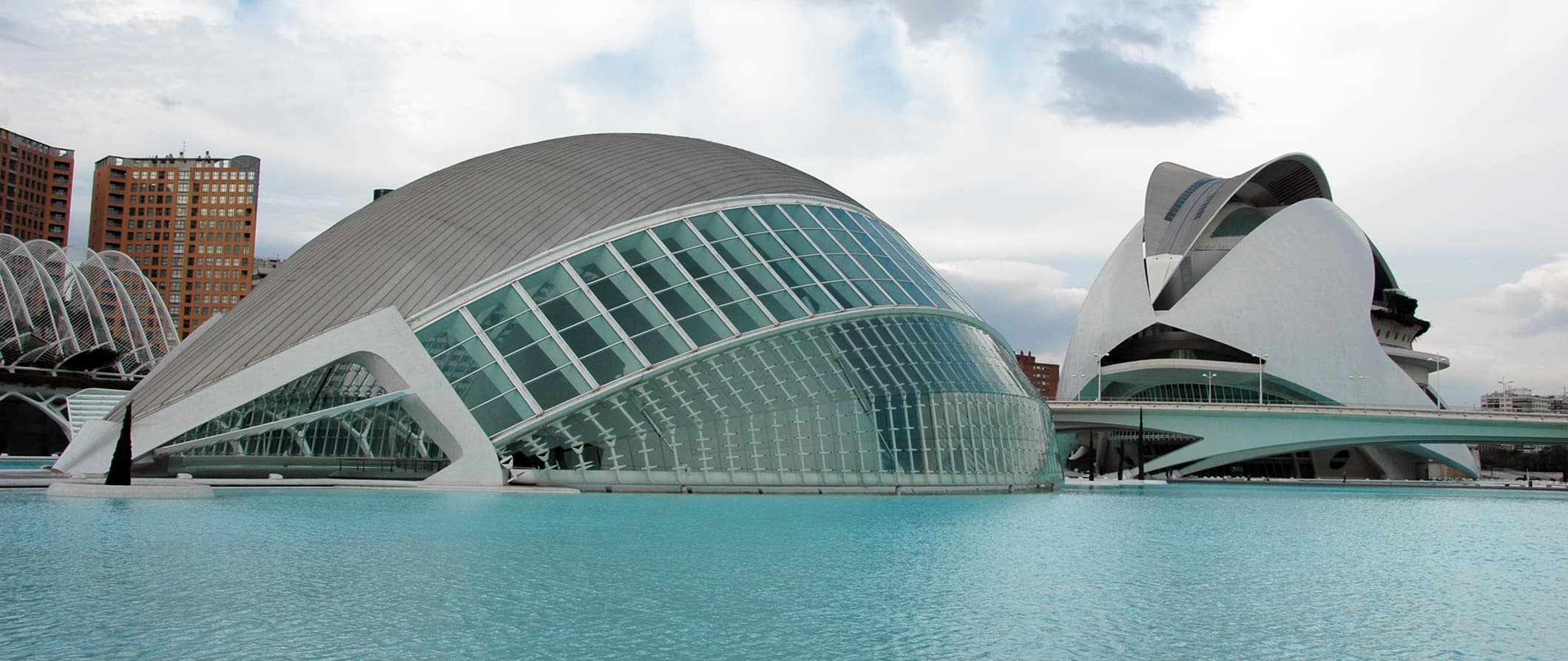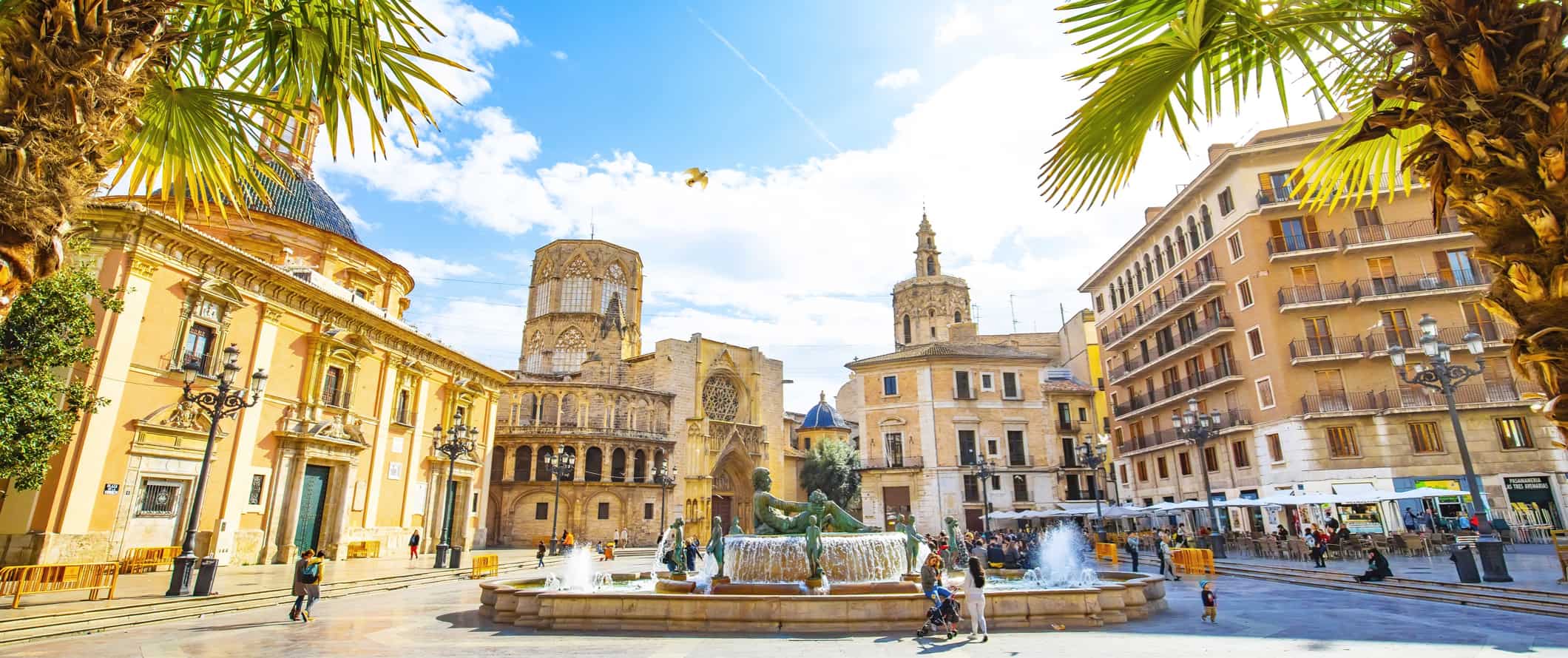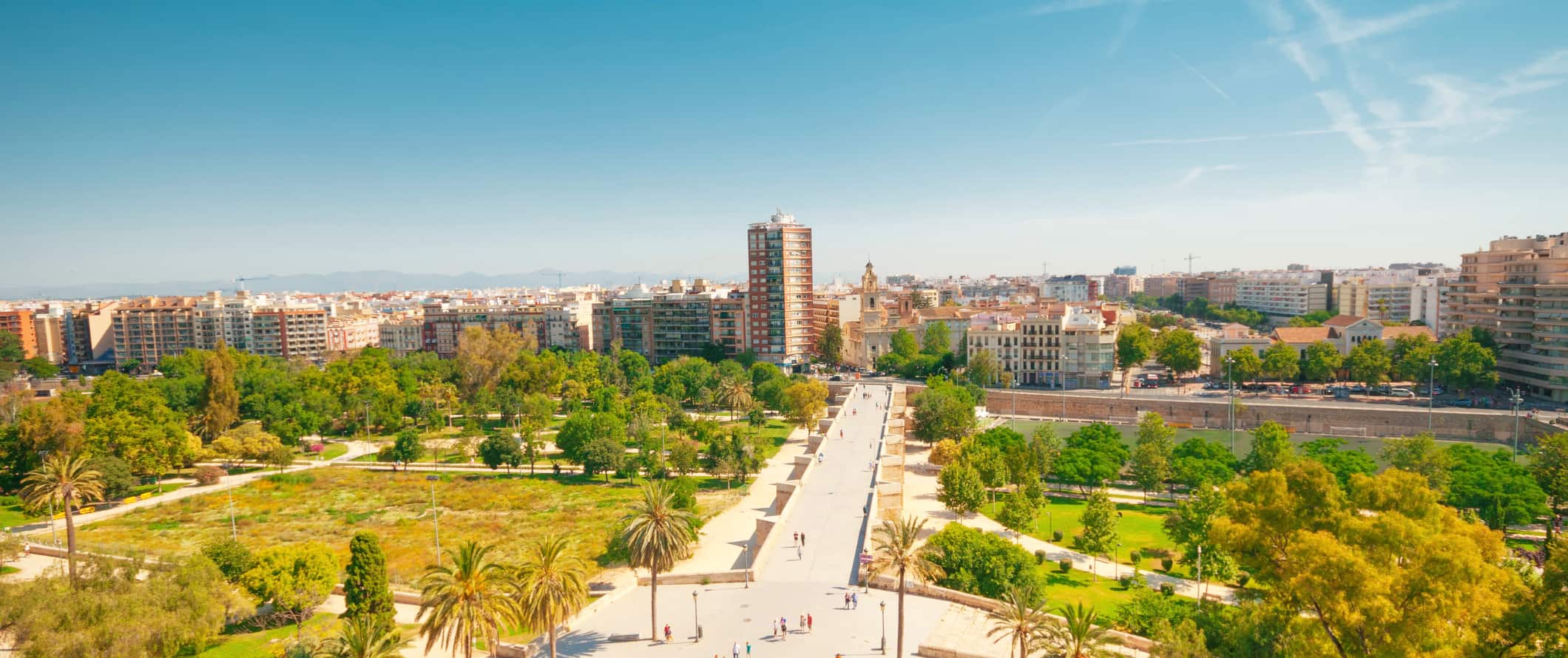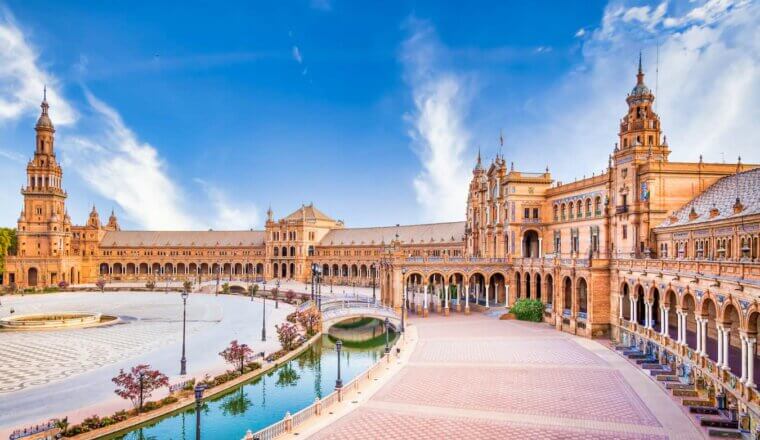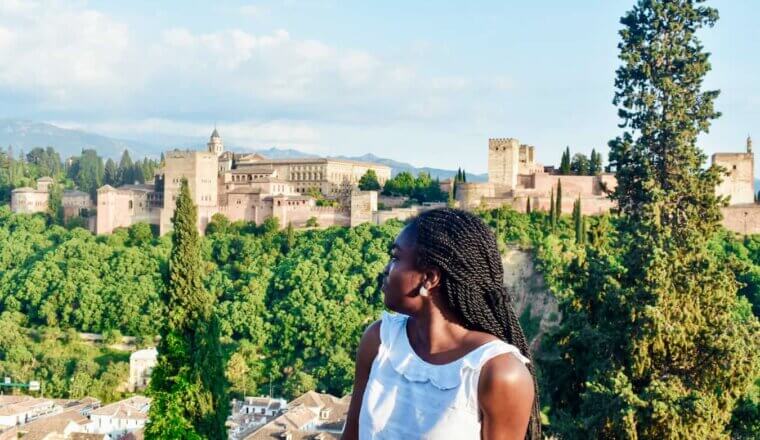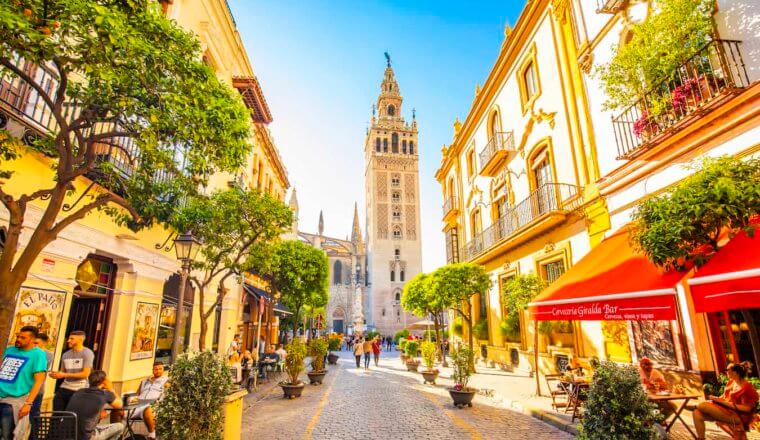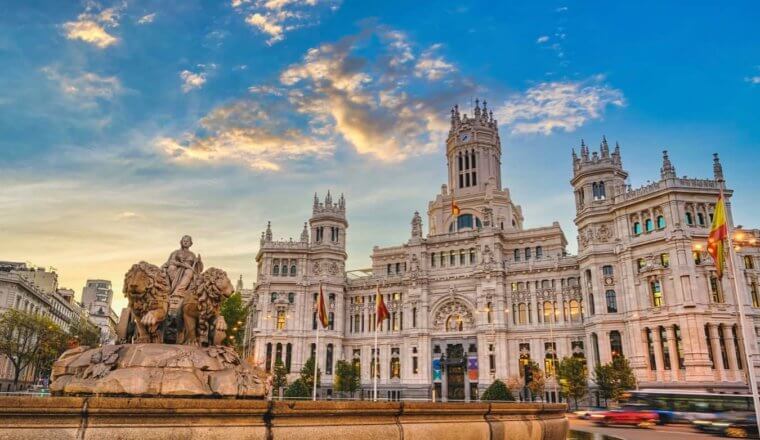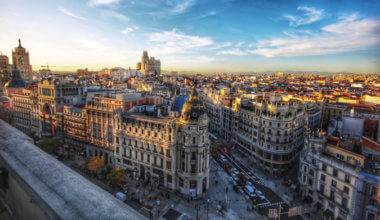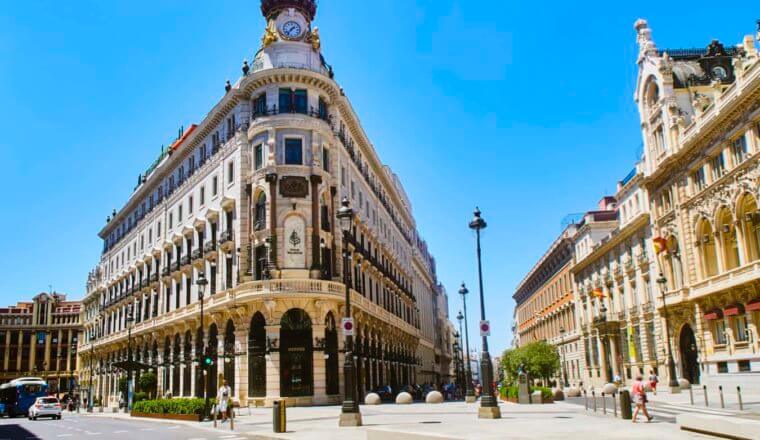I first visited Valencia when I went to the famous La Tomatina festival in nearby Buñol. Valencia was just the city I was going to be sleeping in before and after the festival; I didn’t have any plans on spending much time there.
However, after I wandered the streets, relaxed on the beach, stuffed my face with paella on the seaside boardwalk, and visited the futuristic art museum, I left realizing Valencia had grown on me. It was a cool city with tons of history, art, and good vibes.
Originally a Roman colony and once the capital of Spain, Valencia is the birthplace of paella (and is allegedly home to the Holy Grail). With three UNESCO Sites, one of the largest markets in Europe, and the massive City of Arts and Science complex, Valencia is well worth a visit. I’d recommend spending at least three days here.
This Valencia travel guide can help you plan your trip and make the most of your time here.
Table of Contents
Top 5 Things to See and Do in Valencia
1. Visit the City of Arts and Sciences
This huge complex is a piece of art in itself. Its futuristic look and design makes it one of the most photographed places in Valencia. Construction started in 1996 and the first part of the complex opened in 1998 (with the newest addition opening in 2009). The complex is one of the 12 Treasures of Spain and sees over 4 million visitors each year. It’s home to an IMAX theater, planetarium, museum, opera house, and more. Admission to the museum is 6.20 EUR. A combo ticket is 29.50 EUR.
2. Throw tomatoes at La Tomatina
Started in 1945, this festival is held on the last Wednesday of August in neighboring Buñol. La Tomatina is an epic hour-long tomato fight that draws upwards of 20,000 people to the small town (only 10,000 people live in the town itself). Over 360,000 pounds of tomatoes are used during the festival. It’s the most amazing festival I’ve ever been to!
3. Wander Casco Histórico
This is the historic district of Valencia where you can find the Plaza de la Virgen, the Valencia Cathedral, and where you can explore the ancient winding streets of the Barrio del Carmen and its typical Spanish-style buildings with their large doors, balconies, and windows. The history here stretches back over 2,000 years and the region was home to the Romans, Visigoths, and Muslims over the centuries. It’s also one of the largest historic centers in Europe, making it the perfect place for a stroll.
4. Retreat to the Albufera
This beautiful freshwater lagoon is the largest in Spain. Located several miles outside the city, it’s part of a national park and is full of scenic nature and hiking trails (there are 6 different trails to choose from). There are also over 300 species of birds here, making it a perfect place to spot wildlife. You can take a city bus there in under an hour for just 1.50 EUR. Boat tours cost 10-20 EUR.
5. Cross Calatrava’s Bridge
This was designed by Valencia’s most famous son, Santiago Calatrava, who also designed the City of Arts and Sciences, the Hemisferic, and the Umbracle. It’s a very modern and ultra-cool-looking bridge worth seeing up close. There’s not much to do here, but you can’t visit the city without walking across it and snapping some photos.
Other Things to See and Do in Valencia
1. Take a free walking tour
My favorite way to get to know a city is to take a free walking tour. They’re a budget-friendly way to see the main sights and connect with a local guide who can answer all your questions. Free Tour Valencia offers a daily tour that lasts a couple of hours and covers all the main sights. Just be sure to tip your guide at the end!
2. Admire Valencia Cathedral
In the 8th century, the Balansiya mosque stood on this site. It wasn’t until the 13th century that the present Gothic-style cathedral was built, which took almost two centuries to complete. Today, the cathedral is home to an ornate Holy Chalice considered by some to be the actual Holy Grail. The chalice dates to the 1st century and has been used by various Popes over the centuries. It’s 8 EUR to tour the cathedral and museum (including an audio guide) and an additional 2 EUR to go up the octagonal bell tower (known as “Miguelete”).
3. Explore Central Market
Although this site originally started out as an open-air market, the city decided to move it indoors in the 19th century. Officials hosted several architectural competitions to come up with a new design. The result was a brand new modernist style known as Valencian Art Nouveau, which somewhat resembles a cathedral with its roof domes and the large cupola at the center. The entire building is filled with iron columns, bright ceramic tiling, and delicate stained glass. It’s one of the largest markets in Europe. Come here to people watch, shop for souvenirs, and sample tapas.
4. Visit La Lonja
This 15th-century former silk market and commodity exchange were built between 1482-1533. It’s located in a late Valencian-Gothic building with soaring ceilings and an austere, castle-like appearance. Walk through the main gate and into a cool courtyard filled with orange trees and see the Pavilion of the Consulate of the Sea, with its richly decorated ceilings and an elaborate stone staircase. Found in the Old Town, it’s just around the corner from the Central Market. It’s 2 EUR to visit.
5. Celebrate Las Fallas
This festival in March is one of the biggest in Valencia. It celebrates the arrival of spring and locals construct huge model heads and sculptures and then burn them down in a dramatic finale. According to legend, this “build and burn” follows the Pagan tradition where people would gather their unwanted belongings in the streets and then burn it all to welcome spring. Las Fallas goes on for a full month. Be prepared to celebrate until the wee hours of the morning!
6. Cycle the Jardí del Túria
Jardí del Túria is a long stretch of park that runs through an old dried-up riverbed (the river was diverted to prevent flooding in the city). The government wanted to build a road in its place, but locals fought for the green space to be made instead. It’s dotted with sculptures, sports fields, parks, and buskers. Rent a bike, pack a picnic, and spend a couple of hours taking in the sights.
7. Lounge on the beach
Although this isn’t as much of a beach destination as the Costa Blanca further south, you can still find beautiful sand at the beaches in Valencia. Malvarosa is the most popular place to hang out but be prepared for high prices if you plan to eat here. Las Arenas, Patacona, and El Saler and other popular choices.
8. Eat paella
Valencia is the birthplace of paella (there are several kinds of paella now; this version is known as Valencian paella). The rice dish takes its name from the Valencian word for frying pan (referring to the pan the paella is made in). The original Valencia version is traditionally made with rabbit, snails, and green beans, and has been around since the 1800s. It’s a major part of the culture so be sure to try some while you’re here!
9. Admire the port
The port of Valencia is often filled with international sailboats sporting flags from all over the world. Valencia has hosted numerous America’s Cup Competitions, so the city has a great boating tradition. Take a wander around the port and soak up the maritime lifestyle.
10. Explore the Sagunto Roman settlement
Around 30 kilometers (18 miles) from Valencia is the coastal town of Sagunto. It was both an Iberian and Roman settlement and still has several historic sites to explore, including a castle that overlooks the town, a heavily restored Roman theater, and city walls that date back to the Islamic occupation. There’s a history museum here as well as an exhibition room at the top of the castle. The town has some nice churches to admire too. The bus to Sagunto takes about 30 minutes and costs 2 EUR.
11. Check out Valencia’s towers
In addition to the cathedral’s Miguelete tower there are two more towers to see in Valencia, both of which make up some of the only remains of the ancient city wall (the wall had 12 towers but was pulled down in 1865). There is the Gothic Serrans Tower or Serrano Tower which was built at the end of the 14th century. It’s one of the best-preserved monuments in Valencia. The other tower is the 15th-century Quart Towers which has been used for a variety of purposes over the years including a women’s prison and a military prison.
12. Visit the Ceramics Museum
The Palacio del Marqués de Dos Aguas, one of Spain’s best examples of Baroque architecture, is home to the González Martí National Museum of Ceramics (Museo Nacional de Cerámica y Artes Suntuarias González Martí). Founded in 1947, here you can find an enormous collection of ceramics, some dating from the 18th century. The museum also has some of Picasso’s works. Admission is 3 EUR.
13. Wander the Museum of Fine Arts
The building this museum is in is a work of art itself. Built between 1683 and 1744, it was originally a seminary college (its architect was Juan Bautista Pérez Castiel, who also designed Valencia Cathedral). The museum has art by medieval painters and by painters from the Valencian School. It also has works well-known artists including Pintoricchio, Andrea del Sarto, Van Dyck, Murillo, Velázquez, El Greco and Goya. Exhibits include drawings, etchings, sculptures, and archaeological pieces. It’s free to enter.
14. Visit the Caves of Sant Josep
The Caves de Sant Josep are a system of natural underground caves located in the longest navigable underground river in Europe. LED lights illuminate the UNESCO-recognized paintings and engravings on the walls, which you can admire as you cruise along the river. You can also kayak through the caves on a two-hour tour. Boat tours cost 14 EUR and kayaking is 40 EUR (book in advance). The caves are a 45-minute drive from the city.
For more information on other cities in Spain, check out these guides:
Valencia Travel Costs
Hostel prices – During peak season, a bed in a 4-6-bed dorm costs around 23 EUR. Free Wi-Fi is standard and a few hostels in the city include free breakfast. For a room with eight beds or more, expect to pay around 18 EUR per night. During the off-season, a bed in a dorm room with eight beds or more costs from 10 EUR per night while smaller rooms cost 15 EUR.
A basic private hostel room for two starts at 60 EUR per night during peak season. Prices drop to 50 EUR in the off-season.
Camping is available just outside the city, with plots ranging from 10-20 EUR per night for a basic tent plot for one person without electricity.
Budget hotel prices – Hotels start around 60-80 EUR. While a few budget hotels in the city offer free breakfast or a pool, most are pretty basic so don’t expect anything too luxurious.
Airbnb is available around the city, with private rooms starting at 30 EUR per night (but averaging closer to 65 EUR). If you want an entire home/apartment, expect to pay at least 100-120 EUR per night (though prices can easily be double that when not booked in advance).
Food – In Valencia, paella is one of the major culinary staples, owing to its origin here. Other favorites include arròs negre (a squid and squid ink paella), cured sausages, gazpacho, and all el pebre (a local stew-type dish made from garlic and peppers).
A casual meal of traditional Valencian cuisine costs around 12 EUR. If you want a multi-course meal and a drink, expect to pay 20-25 EUR.
If you plan to eat at the beach, expect to pay close to 10 EUR for a sandwich and 30 EUR for a seafood dinner. Beer and wine are about half-price if you buy them yourself (instead of at a bar or restaurant).
Cheap fast food (think McDonald’s) costs around 8 EUR for a combo meal. Pizza is around 8-10 EUR while Chinese food ranges from 7-12 EUR for a main dish.
Beer is usually around 3 EUR while a latte/cappuccino is under 2 EUR. Bottled water under 1 UR.
If you buy your own food, expect to spend 35-45 EUR for a week’s worth of groceries. This gets you basic staples like rice, pasta, seasonal produce, and some meat.
Backpacking Valencia Suggested Budgets
If you’re backpacking Valencia, expect to spend about 50 EUR per day. This budget covers a hostel dorm, cooking yall our meals, using public transportation to get around, limiting your drinking, and doing mostly free activities like walking tours and hanging out at the beach.
On a mid-range budget of about 145 EUR per day, you can stay in a private Airbnb or private hostel, eat out for most meals, take the occasional taxi to get around, enjoy a few drinks, and do more paid tours and activities like seeing the City of Arts and Sciences and the Cathedral.
On a “luxury” budget of 260 EUR or more per day, you can stay in a hotel, eat out anywhere you want, drink as much as you’d like, take more taxis or rent a car, and do as many paid tours and activities as you want. This is just the ground floor for luxury though. The sky is the limit!
Valencia Travel Guide: Money-Saving Tips
Valencia is generally quite an affordable to visit. It’s much cheaper than Madrid or Barcelona. However, food, drinks, and tours can really add up if you aren’t watching your spending. Here are some tips on how to save money in Valencia:
- Take a free walking tour – Free Tour Valencia offers a variety of free walking tours that can introduce you to the city and show you the lay of the land. Just be sure to tip your guide at the end!
- Budget extra for food – Valencia has a lot of wonderful seafood restaurants (it’s what the city is famous for). Splash out once in a while and get a good meal down by the beach.
- Cook more meals – When you’re not splurging on eating out, stick to buying your own groceries and cooking your meals. It’s not fancy, but it’s much cheaper and will help you save money for those nicer meals.
- Visit the Mercado Central – This is the main fruit and vegetable market in Valencia. Buy snacks, small meals, and groceries here to cut down on your food budget and give you a taste of local life.
- Stay with a local – While hostels are cheap in the city, staying with a local drastically lowers your expenses. It’s also a great way to connect with the local scene and get a better sense of the city and its people. Use Couchsurfing to find a local host who can show you around. Just be sure to send your requests early.
- Get the tourist card – If you plan on seeing a lot of attractions and using a lot of public transportation, consider getting the Valencia Tourist Card. It comes in 1-,2-, and 3-day options for 15 EUR, 20 EUR, and 25 EUR respectively. It offers discounts all over the city in addition to free transportation and free entry into certain attractions.
- Bring a water bottle – The tap water here is safe to drink so bring a reusable water bottle to save money and reduce your plastic use. LifeStraw is my go-to brand as their bottles have built-in filters to ensure your water is always clean and safe.
Where to Stay in Valencia
There are several excellent hostels in Valencia. My recommended places to stay are:
How to Get Around Valencia
Valencia is a small city so walking is the best way to see everything. However, public transportation is cheap and can get you anywhere you need to go too.
Public transportation – Buses cost 1.50 EUR per trip within the city limits. A 24-hour Valencia Tourist card gives you free transit and costs 15 EUR.
Valencia’s underground subway is particularly useful in the summer months because of the air conditioning. A one-way ride costs 1.50 EUR and the metro also reaches the airport.
Getting to and from the airport is straightforward, with one-way city bus tickets costing 1.50 EUR.
Bicycle – Bikes can be rented in the city, either per hour or per day, with prices varying depending on the season. Expect to pay around 10-15 EUR per day (or just 6 EUR for three hours).
Taxis – Taxis start at 4 EUR, with the normal tariff being 1 EUR per additional kilometer. Skip them if you can as the prices add up fast!
Ridesharing – There is no Uber in Valencia but there is an app called Cabify that works in a similar way. However, like taxis, prices add up fast. Skip the rideshares if you can.
Car rental – Car rentals can be found for as little as 25 EUR per day for a multi-day rental, however, you don’t need a car to get around the city. Unless you’re going to explore the surrounding region, skip the car rental. For the best rental car deals, use Discover Cars
When to Go to Valencia
Because of Valencia’s temperate climate (it sees more than 300 days of sun per year), beach season extends from July to October. During this time it can get crowded. Expect daily highs above 31°C (88°F) in the summer.
Personally, I think the best time to visit is in late spring or early autumn when crowds haven’t peaked but the weather is still warm enough for swimming but not too hot for exploring on foot.
In the winter (December-February), the weather is still comfortable, reaching highs of 18°C (65°F). While the crowds disappear during this time, some museums have shortened hours.
Keep in mind during the Las Fallas de San José festival in March, accommodation books up quickly so allow plenty of time for planning (prices rise too).
How to Stay Safe in Valencia
Valencia is a safe place to visit. Violent crime is rare, but like other Spanish cities, pickpocketing is common (especially in the major tourist areas and on public transportation). Keep your valuables secure and out of sight at all times.
When at a cafe or restaurant, don’t leave any valuables on the table unattended. They can disappear quickly.
Solo female travelers should feel safe here. However, the standard precautions apply (don’t leave your drink unattended at the bar, don’t walk home alone intoxicated, etc.).
Tourist scams are prevalent as well so keep an eye out for groups of kids trying to distract you, as they’re probably trying to take your money. Also, be wary of people offering to carry your luggage. They may try to charge you a large fee. You can read about common travel scams to avoid here.
When out at the bar, always keep an eye on your drink. Avoid walking home alone at night if intoxicated.
If you experience an emergency, dial 112 for assistance.
The most important piece of advice I can offer is to purchase good travel insurance. Travel insurance protects you against illness, injury, theft, and cancellations. It’s comprehensive protection in case anything goes wrong. I never go on a trip without it as I’ve had to use it many times in the past. You can use the widget below to find the policy right for you:
Valencia Travel Guide: The Best Booking Resources
These are my favorite companies to use when I travel. They consistently have the best deals, offer world-class customer service and great value, and overall, are better than their competitors. They are the companies I use the most and are always the starting point in my search for travel deals.
- Skyscanner – Skyscanner is my favorite flight search engine. They search small websites and budget airlines that larger search sites tend to miss. They are hands down the number one place to start.
- Hostelworld – This is the best hostel accommodation site out there with the largest inventory, best search interface, and widest availability.
- Booking.com – The best all around booking site that constantly provides the cheapest and lowest rates. They have the widest selection of budget accommodation. In all my tests, they’ve always had the cheapest rates out of all the booking websites.
- HostelPass – This new card gives you up to 20% off hostels throughout Europe. It’s a great way to save money. They’re constantly adding new hostels too. I’ve always wanted something like this and glad it finallt exists.
- Get Your Guide – Get Your Guide is a huge online marketplace for tours and excursions. They have tons of tour options available in cities all around the world, including everything from cooking classes, walking tours, street art lessons, and more!
- The Man in Seat 61 – This website is the ultimate guide to train travel anywhere in the world. They have the most comprehensive information on routes, times, prices, and train conditions. If you are planning a long train journey or some epic train trip, consult this site.
- Rome2Rio – This website allows you to see how to get from point A to point B the best and cheapest way possible. It will give you all the bus, train, plane, or boat routes that can get you there as well as how much they cost.
- FlixBus – Flixbus has routes between 20 European countries with prices starting as low 5 EUR! Their buses include WiFi, electrical outlets, a free checked bag.
- SafetyWing – Safety Wing offers convenient and affordable plans tailored to digital nomads and long-term travelers. They have cheap monthly plans, great customer service, and an easy-to-use claims process that makes it perfect for those on the road.
- LifeStraw – My go-to company for reusable water bottles with built-in filters so you can ensure your drinking water is always clean and safe.
- Unbound Merino – They make lightweight, durable, easy-to-clean travel clothing.
- Top Travel Credit Cards – Points are the best way to cut down travel expenses. Here’s my favorite point earning credit cards so you can get free travel!
- BlaBlaCar – BlaBlaCar is a ridesharing website that lets you share rides with vetted local drivers by pitching in for gas. You simply request a seat, they approve, and off you go! It’s a cheaper and more interesting way to travel than by bus or train!
Valencia Travel Guide: Related Articles
Want more info? Check out all the articles I’ve written on Spain travel and continue planning your trip:
